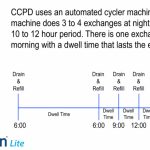Continuous Ambulatory Peritoneal Dialysis (CAPD) is a form of renal replacement therapy that provides a convenient and effective treatment option for individuals with end-stage renal disease (ESRD). Unlike hemodialysis, which requires frequent visits to a dialysis center, CAPD allows patients to perform dialysis at home or in any clean environment.
CAPD works by utilizing the peritoneal membrane, a thin layer of tissue that lines the abdominal cavity, as a natural filter. A cleansing solution called dialysate is introduced into the peritoneal cavity through a catheter, and as the patient goes about their daily activities, waste products and excess fluid from the bloodstream pass through the peritoneal membrane and into the dialysate. The dialysate is then drained and replaced with fresh solution several times throughout the day.
One of the key advantages of CAPD is its flexibility and convenience. Patients have the freedom to perform their dialysis treatments at a time and place of their choosing, allowing for greater independence and improved quality of life. CAPD does not require a machine, making it more accessible for those living in remote areas or with limited access to healthcare facilities. Additionally, the continuous nature of the treatment helps to maintain stable fluid and electrolyte levels in the body, reducing the risk of complications.
CAPD also offers benefits in terms of preservation of residual kidney function. The continuous nature of the treatment allows for better clearance of waste products, while preserving some level of kidney function. This can lead to better overall health outcomes and potentially delay the need for transplantation or other more intensive forms of dialysis.
However, CAPD does require a certain level of commitment and adherence to a strict treatment regimen. Patients must perform regular exchanges of dialysate, follow proper sterile technique to prevent infection, and monitor their weight and fluid intake closely. Regular follow-up visits with healthcare providers are also necessary to ensure the treatment is effective and any potential issues are addressed promptly.
In conclusion, Continuous Ambulatory Peritoneal Dialysis (CAPD) offers a convenient and effective dialysis option for individuals with end-stage renal disease. Its flexibility, independence, and ability to preserve residual kidney function make it an attractive choice for many patients. However, it is important for patients to fully understand the treatment and commit to the necessary care and monitoring to ensure optimal outcomes. Consultation with healthcare professionals is crucial in determining the suitability of CAPD as a treatment option for each individual case of ESRD.
There are 2 types of peritoneal dialysis: Continuous ambulatory peritoneal dialysis (CAPD) and Continuous cycling peritoneal dialysis (CCPD). These types may be used in combination. You can also switch from one type to the other.


